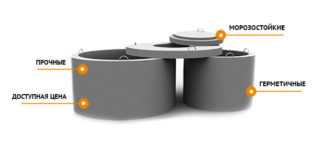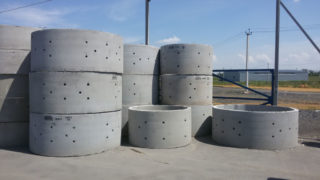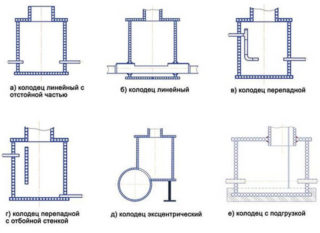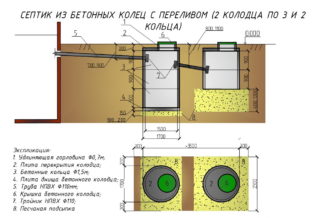The easiest way to build a septic tank on the site of a private house is with concrete rings. The only design flaw is the heavy weight, but that also makes sense. Reinforced concrete sewerage system is stable, airtight, not affected by ground movements. The price of reinforced concrete sewer wells is the lowest of all available options.
Advantages and disadvantages of reinforced concrete sewer wells

Concrete rings are a very durable material for any sewage system: storm, drainage or fecal. The material does not allow moisture to pass from the inside, so the soil remains clean. Other advantages of a concrete drain:
- It is possible to choose rings - perforated, solid, with or without a lock.
- Together with the main parts, additional ones are produced - floors, bottom parts, hatches. There are special parts with already existing openings for the supply of sewer pipes.
- It is used in different climatic regions due to its high performance properties - concrete is not exposed to high and low temperatures.
- Installed quickly when using a construction crane. In one day, you can prepare a pit and put rings.
- Thanks to the special iron brackets, the septic tank made of concrete rings can be cleaned.
- The material is chemically resistant to aggressive liquids, therefore it can be used for any purpose, not only for home autonomous sewage.
- The parts are made in such a way as to ensure the most snug fit to each other.
When preparing concrete rings for installation in the ground, it is necessary to ensure an even bottom so that the load is evenly distributed. This will serve as a guarantee of long-term operation. It happened that on one side the soil sagged and the lower ring cracked under the weight of the upper ones.
Application area

Sewer wells are used in autonomous private systems, as well as in urban underground utilities. With their help, it is possible to equip a waste processing station in the private sector. In this case, not only standard round parts are used, but also rectangular containers of large volume for biological treatment plants. The cost of such an object is quite high for one person, but for the entire village the price will be moderate, and the issue of water purification for subsequent discharge into local water bodies will be resolved without the risk of disrupting the ecological situation.
For the suburban area, small-volume concrete products are used. If the septic tank is sealed, the contents can be regularly used as organic fertilizer for the soil. For this, special preparations based on bacteria are used, which destroy odor and turn fecal matter into a useful nutritional supplement for plants. Do it in summer or autumn.
The use of iron reinforcement in the production process gives products additional strength. Reinforced concrete structures are used in urban underground utilities located under highways with increased loads and vibrations.
The maximum diameter of the ring is 2 m, the height is 90 cm, but according to the requirements of SNiP, the sewerage depth should not exceed 2.5 m.If, with these parameters, the volume of the septic tank is not enough, you will have to make a two-chamber sewage system - one tank for the accumulation of waste with a sealed bottom, the other for a relatively clean liquid without solid particles.
Actual installation requirements
The following conditions must be taken into account when installing and purchasing materials for a sewer well:
- The volume of the septic tank is determined at the rate of 150 liters per day per person. Water consumption for household appliances is not included here.
- It is necessary to exclude sharp turns of the highway. Such areas are potentially dangerous in operation, as they create conditions for the occurrence of blockages. The inlet and outlet pipes are connected at an obtuse angle greater than 90 degrees. For this, several couplings are used - usually 2, if you need to turn the pipes at right angles.
- When turning, pipes of the same diameter are used and revision shafts are installed.
- For the construction of a sewer well from concrete rings, a special brand of solution is used - fine-grained concrete. The production technology is vibration.
- To distribute the load and stability, it is necessary to use reinforcement on the sides of the structure and a reinforcing mesh under the bottom of the product.
- Depending on the type of soil, concrete of low or normal permeability is selected.
- A distance of at least 5 meters is maintained between the dwelling and the septic tank.
- A storage septic tank with an open bottom should be located at least 25 meters from sources of drinking water. If the container is sealed, the distance does not matter.
Before installation, calculations and marking of all elements of the sewage system on the ground are necessarily carried out, including the removal of vegetation and objects that interfere with land work.
Types of wells
- Accumulative - for the collection and storage of wastewater. The widest products are used.
- Crossover - settles down at the junction of the home highway with the central one, if such is provided. In the private sector, such structures are not made.
- Inspection or revision - for installation in critical areas - bends, branches, at the intersection of several pipes. There are ordinary and service options. In this case, the diameter is chosen in which a person can be and do the work.
- Filtration - designed to store water without harmful chemicals, for example, rainwater or runoff from a bath, pool. They differ in that they have perforated walls; as they fill, the liquid flows out through the holes and is absorbed into the soil.
In addition to sewerage, concrete rings are used for the construction of wells, if the depth of the groundwater is not more than 10 m. A well is built at a depth of more than 10 m.
Reinforced concrete well accessories
In addition to the main parts - concrete rings - it is possible to purchase separately:
- bottom;
- manhole cover;
- ceiling wall with a hole for the hatch.
If it is planned to equip additional inspection wells on the site, they buy rings of a smaller diameter with a hatch and a cover.
Features and installation rules
Stages of construction of a septic tank made of concrete rings:
- Preparation of a pit of the required size. The gaps between the walls of the rings and the pit are about 30 cm.
- If the bottom is planned to be open, the first ring is installed immediately; if it is sealed, first you need to fill the bottom with concrete with a reinforcing mesh. For this, sand is poured, compacted. A metal mesh is laid and poured with concrete. When it hardens, work continues and all rings are installed in turn, using a building level to lay the products evenly.
- After horizontal and vertical alignment, the joints are covered with a water-repellent solution or cement.
- The upper hole is covered with a slab with a hatch hole equipped with a chamfer.
- If it was possible to pick up a ring with a hole for the incoming pipe of the required diameter, it is simply inserted into the septic tank and sealed. If the ring is solid, a hole is made in it before connecting the pipe.
After connecting the pipe and checking the system, you can fill the gaps with sand and earth.
Product prices
In addition to the price of the materials themselves and additional parts, the cost of earthworks is taken into account: digging a pit for a septic tank and a sewer main. Depending on depth and length, an excavator may be required to complete the job in one day.
The grade of concrete, the method of production of products, as well as the dimensions of the rings for sewer wells with a certain wall thickness, the presence of additional devices - brackets for descent into the septic tank, locks for joining parts are taken into account. It is better to order delivery in a store so that the concrete structures are not damaged during loading and transportation.











